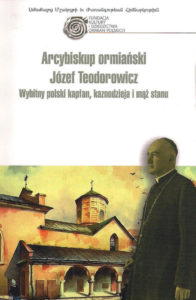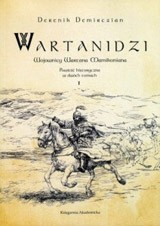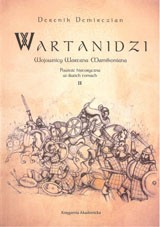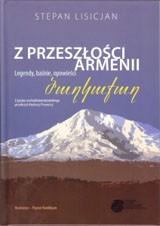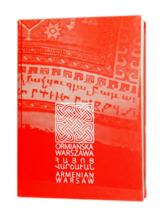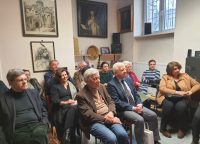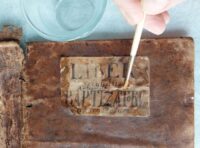GALLERY
PUBLICATIONS
NEWS
Promotion of the Publication – Women with Pastorals
At the headquarters of the Foundation for the Culture and Heritage of Polish Armenians on February 25, 2023, a solemn promotion of the publication “Women with Pastorals. Portraits of the Duchess of the Benedictine Armenian Nuns in Lviv; history, contexts, comments” was held.
We were honored by the presence of many important guests, including Professor Antoni Kamiñski from the Polish Academy of Sciences – Academy of Kresy Heritage, Dorota Janiszewska-Jakubiak – Director of the National Institute of Polish Cultural Heritage abroad “POLONIKA”, Polish ambassadors in Armenia – Marianna and Tomasz Knoths and Jadwiga and Jerzy Nowakowskis, Priest Professor Jozef Naumowicz, PriestPrelate Aleksander Seniuk, representatives of the media, many supporters and friends of the Foundation.
However, the most important guests from Krakow were Professor Krzysztof Stopka, director of the Jagiellonian University museum, Collegium Maius and the authors of the publication Professor Andrzej A. Zięba – director of the Center for Research on the Culture of Polish Armenians, Jolanta Pollesch – Chief Conservator of the Jagiellonian University museum and Jolanta Sławinska, art historian of Krakow’s Collegium Maius. Among the authors was also our friend Monika Agopsowicz. The others – Tomasz Krzyżowski, Marcin Łukasz Majewski and Marek Stasiowski unfortunately could not take part in this meeting.
New issue of LEHAHAYER magazine
 The next, 9th issue of the Lehahayer magazine edited by Andrzej A. Zieba has been published.
The next, 9th issue of the Lehahayer magazine edited by Andrzej A. Zieba has been published.
Marcin Łukasz Majewski opens this issue with an article devoted to the records of the Armenian parish in Zamość. Andrzej A.Zięba writes about the manuscript songbook of the Armenian Benedictine nun Antonina Grzegowiczówna from 1757. Among the published publications, we will find an article devoted to the Benedictine nuns of the Latin and Armenian rites, their mutual relations and coexistence until the time of expatriation from Lviv to the new borders of Poland – written by Urszula Ososko
Tomasz Krzyżowski studied old prints from the collection of Archbishop Józef Teodorowicz, and in the second material he dealt with the topic of plans to create a Slavic-Armenian-Catholic church union in the 1930s.
Ewa Siemieniec-Gołaś explored the scientific achievements of Professor Edward Tryjarski in terms of his research on the Armenian-Kipchak language. Of course, these are not all the materials included in this interesting magazine.
An unusual discovery in an old record book
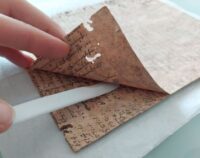 More archives saved within the framework of the latest edition of the competition “Supporting archival activities”. We start with summaries therefore.
More archives saved within the framework of the latest edition of the competition “Supporting archival activities”. We start with summaries therefore.
At the beginning, Discovery in the Foundation for Culture and Heritage of Polish Armenians.
– Such an entry appeared on the website of the State Archives
https://www.facebook.com/ArchiwaPanstwowe/?locale=pl¬_PL
In the archives of the Foundation for the Culture and Heritage of Polish Armenians the oldest Armenian record books from the Armenian church in Stanislawów have undergone full conservation; the book of baptisms 1703-1783 and the book of deaths 1715-1829. They have been disinfected and fully preserved. During the conservation work the extraordinary discovery was made. In the leather bindings of the books 54 cards from the 18th century were found. The find was extracted from its covers, separated and cleaned. The procedures carried out thus allow not only for safe research on the contents of the books, but also on those hitherto unknown manuscripts, which may turn out to be valuable material for historians. Thanks to conservation the process of destruction of the oldest Armenian record books kept in the Archives of the Foundation for Culture and Heritage of Polish Armenians has been stopped. The books have been secured and they can be safely used without exposing the material to destruction and health of users to the action of microorganisms.
One of the preserved books can be seen in the permanent exhibition at the Foundation’s headquarters (Warsaw, 12 Świętojerska str.)
As the conservator Hanna Machaj says – an important stage of the conservation work was the separation of the covers containing valuable manuscript cards from the leather binding and the full conservation of these cards. The surface of the covers and the leather were covered with a thick layer of dirt. Due to the great weakness and fragility of the paper base of the manuscripts and its susceptibility to mechanical damage the separation and cleaning of the manuscripts was very difficult. We successfully cleaned the cards of mold, dust and other dirt. We numbered them with a pencil and separated them one by one from the rest.
The procedures carried out allow for safe research on these hitherto unknown manuscripts, which may turn out to be valuable material for historians. We presume that among them there are several pages of the Kipchak-Armenian glossary, another part of which had already been discovered in another book from the archives and compiled.
Elaboration of the Legacy
In addition, as part of the Foundation’s work, the legacy of Leon Ter-Oganjan, an important activist of the Armenian community in Warsaw was developed, recorded and packaged. The list of units can be found in the “Search in the Archives”(“Szukaj w Archiwach”) service. They are also available on the Foundation’s website in the Virtual Archive of Polish Armenians.
Our exhibition enjoys great interest
 Yesterday, March 11, 2023, Olga (first from the right in the photo) took her first steps in guiding around our exhibition. For a debut, she does it very well.
Yesterday, March 11, 2023, Olga (first from the right in the photo) took her first steps in guiding around our exhibition. For a debut, she does it very well.
There were visitors who thoroughly learned every detail. Thanks to our multimedia, they watched, among others, in the historical photo the altar from the church in Kamieniec Podolski and in it the painting that hangs on the exhibition. They also learned the history of the image of the Mother of God from this church, which was also presented by Jozef Brandt in his painting “The Armenian Mother of God” from 1870.(We have a life-size copy of this painting.)
Other guests were particularly interested in our publications as well as in publications of the Center for Research on Armenian Culture in Poland and the Armenian Cultural Society.
With great pleasure we were taking round Marianna (and her mother) the schoolgirl , who is preparing the presentation about Polish Armenians in her school. We have already invited her class and even the whole school to see our exhibition.
We encouraged everyone to come to our Armenian holy mass and to visit us on the Night of Museums on Saturday, May 13, 2023. Then, in addition to visiting the exhibition, it will be possible to walk together with our friendly guides.
Some of the people visiting us made an appointment by phone, what we encourage you to do – tel. 502 421 944. We are open every Saturday from 14.00 to 17.00 without making an appointment and we will always be willing to adapt to your expectations.
Foundation team
TREASURY OF POLISH ARMENIANS
We invite you to visit our permanent museum exhibition TREASURE OF POLISH ARMENIANS every Saturday and Sunday from 2.00 pm to 5.00 pm (soon also on Sundays) at 12 Świętojerska Street. Groups of more than five people will be accepted at any dates agreed by phone – 502 421 944.
Thesaurus Armenorum
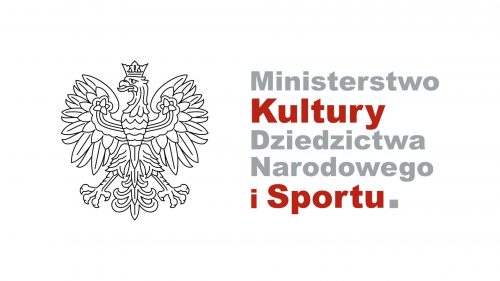 Thesaurus Armenorum – in other words,
Thesaurus Armenorum – in other words,
the Treasury of the Armenians. It is the project that we have been implementing for the last year with a grant from the Ministry of Culture, National Heritage and Sports, the purpose of which was to organize and equip the new seat of the Foundation.
As part of this project, our Archives received professional shelves and a computer for work. In front of the entrance, there is a glass wall with the Foundation’s logo etched in it. In the space that is to perform the exhibition function, we have installed specialized lighting that no museum would be ashamed of. The picture hanging systems were fastened on the walls.
Within the grant we purchased the first two showcases. We were able to hang up finally the pride of our resources – a complete collection of portraits of the Armenian Benedictine Nuns from Lviv, donated to the Foundation. After 70 years they have undergone the necessary maintenance.
After almost a year of strenuous activities and work of the entire team, the interior of the main room is unrecognizable. Only pandemic restrictions prevent us from making our Foundation and its resources available to all interested parties. We hope however that in the spring the situation in this respect will improve and we will be able to celebrate the 16th anniversary of establishing the Foundation for the Culture and Heritage of Polish Armenians with our friends and supporters. We showed the effects of the work achieved thanks to the grant from the Ministry of Culture, National Heritage and Sport, among others in our 2022 calendar and in our annual report.
The project Thesaurus Armenorum – Treasury of the Armenians was co-financed by the Minister of Culture, National Heritage and Sport from the Culture Promotion Fund – a state special purpose fund. Once again, we would like to thank very much for the donation granted, with the hope that the next one we have applied for would also be awarded to us. This will make it possible to finalize the creation of the historical exhibition of the Foundation’s collections. This exhibition would be made available to the inhabitants of Warsaw as well as domestic and foreign tourists visiting our capital.
We invite you to view the photos of the works that were made thanks to the grant from the Ministry of CNHS 2021 FKiDOP_MKiDN
Armenian by origin is a co-winner of the Nobel Prize in the field of medicine
 Ardem Patapoutian and David Julius have been awarded the Nobel Prize in Medicine. They received the award for discovering the temperature and touch receptors.
Ardem Patapoutian and David Julius have been awarded the Nobel Prize in Medicine. They received the award for discovering the temperature and touch receptors.
Ardem Patapoutian is a molecular biologist and neurobiologist of Armenian descent at Scripps Research in La Jolla, California.
In the justification of this year’s award, it was stated; “How are nerve impulses initiated so that we can feel the temperature and pressure. This question has been solved by this year’s Nobel laureates.”
David Julius used capsaicin, a pungent compound derived from chilli peppers that induces a burning sensation to identify a heat-responsive sensor in the skin’s nerve endings.
Ardem Patapoutian used pressure-sensitive cells to discover a new class of sensors that respond to mechanical stimuli in the skin and internal organs.
“Our ability to feel warm, cold and touch is indispensable to our existence and is the basis of our interaction with the world around us. In our daily lives these sensations are obvious to us, but how are nerve impulses initiated so that we can feel temperature and pressure? ”
This question has been solved by this year’s Nobel laureates – it was stated in the explanatory memorandum to this year’s award.
“Laureates identified critical missing links in our understanding of the complex interaction between our senses and the environment”. The Swedish Academy added in the justification to the award.
Fot.:HUFFAKER/AP, ©; Illustrated by: Nikolas Elmehed
More interesting news on this subject: ONET_wiadomości
Scientific Conference – “Caucasus – Past – Present – Future”
Scientific Conference – “Caucasus – Past – Present – Future”
21-22 October 2021
The University of Rzeszów invites all interested in Caucasian issues to Rzeszów for the 10th International Scientific Conference “Caucasus – Past – Present – Future” , which will be held on October 21-22, 2021.
The conference is interdisciplinary and covers the period from antiquity to the latest times.
Its purpose is to present the latest results of research on the Caucasus and to create conditions for discussion and exchange of views of international circles of researchers.
Academics, specialists, researchers, applicants for doctors degree and students from Poland and other countries, especially from the Caucasus region, as well as representatives of the Polish Diaspora from the Caucasus and Caucasian nations from Poland and Europe are invited to participate in the conference.
The conference proceedings will be conducted in Polish, Russian and English.
“The History of Armenia in Three Books” by Mozes Chorenacy has been published
 The “History of Armenia in three books” by Mozes Chorenacy – the next volume, already the fourth in the series “Lehahayer” Library, was published by the Krakow Center for Research on Armenian Culture in Poland.
The “History of Armenia in three books” by Mozes Chorenacy – the next volume, already the fourth in the series “Lehahayer” Library, was published by the Krakow Center for Research on Armenian Culture in Poland.
It is a translation of an important source in the history of Armenia.
The translation was made by Dr. Stanislaw Ulaszek (University of Gdańsk) from the History of Armenia edition by prof. Gagik Sarkisjan (in Russian).
Additional footnotes, comments, introduction and indexes were provided by Professor Andrzej Pisowicz (Jagiellonian University). The cover of the issue was designed by Monika Zolotenka. The publication of the volume was facilitated by a generous donation from Mr. Zbigniew Manugiewicz, a member of the Council of KCRACP. Like the previous volumes, this one was also published by Ksiegarnia Akademicka in Krakow, where it is also available for purchase.
Mowses Chorenacy also called Mozes from Choren is a historian of ancient Armenia. As for his biography, disputes persist in science. Some arbitrarily believe that he lived at the turn of the 8th and 9th centuries.
He himself claimed to be a student of two outstanding personalities of the Armenian Church, active at the turn of the 4th and 5th centuries; Swietego Mesrob, known as Masztoc, author of the Armenian alphabet, and Swietego Sahak, known as the Great. Saint Sahak was a Catholicos, a descendant of Saint Gregory who converted Armenia to Christianity and hence he was called the Illuminator. After the Council of Ephesus (431) they were to send him on a journey through the most important centers of Christianity in Jerusalem, Alexandria, Constantinople and Rome. After his return, Moses dealt with the translation of various works into the Armenian language, and in his old age he wrote the history of Armenia from the most ancient, legendary times until the first half of the 5th century. He based his argumentations on Armenian sources, various Christian writings, the archives of Nineveh and the works of ancient writers. He wrote on the glory of the Bagratuni dynasty, but above all he glorified his homeland, Armenia.
He linked its history with the history of the people of Israel and the most distant fate of Eastern civilization.
As we read in the introduction, the publication is intended for all Poles interested in Armenia, its centuries-old history, old Christian tradition and literature dating back to antiquity.
ARCHBISHOP RAPHAEL MINASSIAN THE NEW CATOLICOS – PATRIARCH OF CILICIA FOR CATHOLIC ARMENIANS
 On September 23, 2021, Archbishop Raphael Minassian,
On September 23, 2021, Archbishop Raphael Minassian,
the former Ordinary of the Armenian Catholic Church for Armenia, Georgia, Russia and Eastern Europe was elected by the Holy Synod of the Armenian Catholic Church as a new Catholicos – the Patriarch of Cilicia for Catholic Armenians. He adopted the name
Rafael Bedros XXI (Pol. Rafał Piotr XXI, Eng. Raphael Peter XXI)
More news; Ordynariat.





